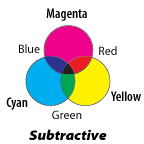
Colour Theory
All colours can be derived from a very few primary colours. You can mix these primary colours together in various percentages to create millions of colours. Depending on the application and environment, Primary Colours fall into three families:
RGB: Red
Blue Green
CMY: Cyan Magenta
Yellow
YRB: Yellow Red
Blue
RGB is used by most electronic and transmissive-light technologies such as TV, computer monitors, and film. They are created by direct light and are therefore called Additive colours. CMY (actually CMYK including Black) is used with reflected light technologies such as printing inks, called Subtractive colours. When light strikes matter, some or all of the light is absorbed. Blue is "blue" because when light hits its surface the pigment absorbs (or "subtracts") all of the colour spectrum except the blue that is reflected to our eyes. YRB are the primaries traditionally taught in art school for painters.
The secondary colors of the additive colour model are the same as the primary colors of the subtractive colour model. As you might conclude from that, the secondary colors of the subtractive world are the primary colors of the additive world. It's all part of the interrelationship between additive and subtractive color modeling.
The primary colours in the following diagrams are Yellow Red and Blue, but the procedures for choosing colour schemes and creating other colours from the primaries are essentially the same. You will need to know which colour mode you are going to create your project in - this is determined by the final format of your project.

(RGB)

(CMY)